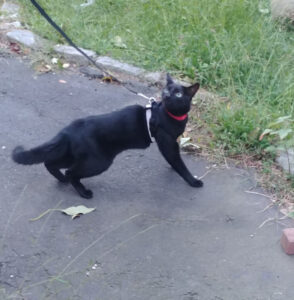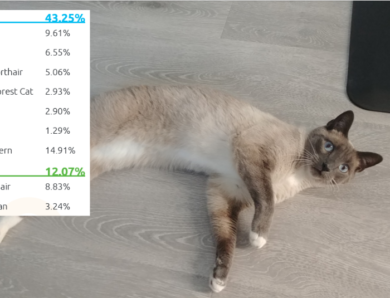
How Do You Leash Train a Cat?
Dog parents don’t have a monopoly on taking their pet for a walk outside.
One of the coolest ways for cat parents to spend time with their feline best friends is outside, exploring the backyard, going for a walk, or even visiting a park or hiking in a national forest.
And while seeing a cat outside on a leash isn’t all that common, that’s not because it’s impossible.
Leash training a cat is fairly easy, as long as your cat has the right temperament.
Scaredy cats (pun intended) do not make good candidates for leash training, but most other cats do.
We can’t promise your cat will be the next Instagram star visiting every National Park with you or going kayaking. But we’d willing to bet, with a little training, your kitty will be thrilled as punch to be outside exploring the yard.
Not sure how to get started?
Here are the easy-to-follow steps to leash train your cat.
(Your Cat Backpack gifted Keeping It Pawsome the three harnesses — small, medium, and large — as well as the leashes, we used to leash train our cats.)
1. Introduce Your Cat to the Harness
Before putting the harness on your cat, place it on the floor for a day or two and let your kitty sniff it, bat it around, and generally get used to its presence.
If you want, you can put the harness near your cat’s food or sprinkle some catnip on it, so it has a positive association for him.
2. Get Your Cat Used to Wearing the Harness
Before putting the harness on any of our cats, we draped it over them so they could feel its weight. All darted away, leaving the harness behind, but in the process, they learned it doesn’t hurt.
Next, at separate times, we put the harness on each cat.
Be prepared: the first reaction from every one of them was to flop down on their side.
Two tried to struggle out of it, but the other just lay there as if it was the heaviest thing in the world and they couldn’t possibly. Ever. Move. Again.
Each cat got a treat with the harness on, even if it meant eating on their side. We then took the harness off. This was repeated several days in a row.
With our two most food-focused cats, we started feeding them their evening food with the harnesses on. This forced them to stand up and move, getting them quickly used to moving about while wearing the harness.
By the way, all of this was done inside the house. Cats should not be put outside on a harness until they are fully comfortable wearing them indoors.
Eventually, we narrowed our focus to just three cats, who 1) seemed to be adapting best, and 2) we know have an affinity for being outside.
See our review of the Outback Jack Cat Tent
3. Add the Leash
Getting your cat used to actually being on the leash can be done indoors or out. If your cat is not used to being outside at all, we’d recommend starting indoors.
Indoor Training
Attach the leash to the harness and just let your cat walk around with the leash loose, dragging behind him. Your cat will probably stop walking at first, and may even bat the leash around. But do this for a few minutes (each time for a little bit longer) each day for a week and he’ll eventually become accustomed to it.
Once your cat is used to the feeling of the leash dragging behind him, start holding onto it while he walks around. Just follow him for the first two to three times.
The next time, hold the leash tight to stop him from going in a direction you don’t want him to. Let him get used to pulling against the leash to learn that once you’ve pulled the leash tight, he can no longer go that way.
As soon as he moves in another direction, give the leash slack. Eventually, he’ll learn that once you’ve stopped his movement in one direction, his only option is to go in a different direction.
You can also use treats as part of his “lessons.”
Let’s say he wants to go straight, but you want him to go into another room. In addition to stopping his forward movement, lay down treats in the direction you want him to go. As he moves toward the treats, he’ll be rewarded with slack in the leash and the treats.
Being outside on a leash can go a long way in keeping your cat from getting bored. Find out more about how to stop boredom in cats.
Outdoor Training

Because the cats we chose to continue leash training with are accustomed to being outside in a tent, we skipped indoor training.
Once they were used to the harness, we went straight outdoors. The process is essentially the same as the second part of indoor training.
In the beginning, just let your cat walk in whatever direction she wants to, following her with some tension on the leash.
Don’t be surprised if your cat takes his part slowly the first few times. Even though our cats are used to being outside in a tent, they were not used to having free rein and were hesitant about moving beyond their comfort zone. (In our case, past where their tent is located on our driveway.)
If your cat moves in a direction you don’t want her to go, simply hold the leash tight. Do not pull on it. Just stop her forward movement.
In the beginning, she’ll most likely tug and strain against it. But eventually, she’ll learn this means she must move in another direction. Or sit down and try to wait you out!
Our Experience
After about two months of practicing with three of our cats, we’ve found that each behaves quite differently on the leash outside.

Noapte only cares about getting to grass he can chew on. In the first few weeks, if we stopped him from going in a direction he wanted, he simply sat down and tried to wait us out. After five or so minutes of waiting for him to move, his stubbornness usually resulted in us scooping him up and carrying him indoors.
Nowadays, he moves sideways if he encounters tension. We have only occasionally been able to get him to move in the direction we want him to go through tension training, but we’ll continue to work on it.
Balotelli, on the other hand, wants to explore. Almost from day one, if he encountered tension, he simply moved in another direction. And he will often (though not always!) follow our lead in choosing which direction to go.
He’s also willing to go the furthest away from the house and even seems to want to explore the street. We’re anticipating taking him for a proper “walk” sooner rather than later.
Monkey is completely different. She mostly just wants to find a sunny spot outside to sit down and relax. She has no interest in exploring or walking.
A Few Extra Notes on Leash Training a Cat
Carry Your Cat Outside
Do not let your cat walk herself out the door with the leash on. If she gets used to walking out on her own, there’s a chance she’ll do it when the leash isn’t on. And then you’ve got a loose cat to chase down.
Don’t Pull on the Leash (or Your Cat)
When trying to get your cat to move in the direction you want, do not pull. Most cats will react to being pulled in one direction by backing up and pulling in the opposite direction.
Because the harness is now being pulled one way and your cat is pulling the other, it is possible at this point for him to slip out of the harness.
Even if he doesn’t get out, the entire thing will be such an unpleasant experience, he won’t want to be in the harness again.
If you absolutely must pull your cat — say to stop him from chasing after another cat — pull upwards enough to stop his movement in any direction.
Better yet? Pick him up and carry him away.
6 Comments
Comments are closed.






Interesting! I have an indoor cat who I know would love to be able to spend some time out of doors. This might be a good solution. Thanks!
Definitely give it a try and let us know how it goes!
Love this! We have a cat that seems interested in the outdoors and perhaps taking her for walks could also help her lose weight!
If you can get her to actually walk, it could be great. With some cats, it’s less walking than just slow exploration.
We have 2 indoor cats, one of them was indoor/outdoor when we lived in another town. I’ve thought about leash training them but I don’t know if I want to hear 2 cats meowing at the door to go out!
That can be an issue. One of ours now wants to go out all the time and lets us know every opportunity he gets!